Hi! It’s review season again! Theros Beyond Death has arrived and offers us new toys for cube owners and i’m excited to get into it with you.
First, and as advertized, Sagas are back. Sagas play out well, their countdown mini-games excellent designs for limited. Of the new ones here in Theros, there are a few that have exceeded my expectations after some testing.
We also have a fistful of new enchantment gods, remixed from their original incarnations. And perhaps the most important of all is Escape, which has proven itself far above even my highest expectations. As it turns out, spells you can cast over and over again—even with some restrictions—can feel broken.
Then there’s constellation, or Enchantment-matters. This is, relatively, the parasitic mechanic of the set. Most of these cards won’t make it into our cubes without a serious commitment to supporting the archetype. Therefore, i’ll only be touching on cards which hold an inherent power level and don’t rely too much on synergy. However, it’s possible that Theros Beyond Death has opened up the possibility of an Enchantment-Matters archetype in rarity restricted cubes.
I won’t be giving out letter grades, but I’ll rate my top cards at the end of each article. We’ll go in WUBRG color order, then Multicolor and Colorless.
You can read previous reviews of White, Blue, Black, Red, and Green.
Without further ado!
Ashiok, Nightmare Muse
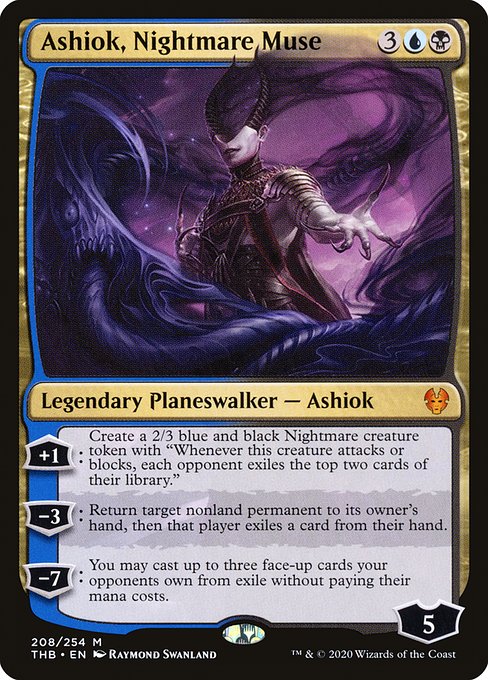
After having stubbornly opposed them for the better part of the last two years, I’ve come around to Planeswalkers. I’ll try not use these evaluations as a soapbox to wax poetic on why, but I think you’ll agree with me that the idea of Planeswalkers have made an irrefutable impact on our game, for better or for worse. Most provide a welcome and meaningful complexity to the game. Some can feel insurmountable. Much of the time this balance is contextual to the format. Even a card like Jace, the Mind Sculptor—once considered the greatest planeswalker of all time—can either feel totally busted or totally fine given the circumstances of the surrounding environment.
Ashiok, Nightmare Muse posits themselves as an excellent control card, complete with a high starting loyalty, the ability to defend themselves with either activation, and is a one-card win condition. This is all fine and good, but Dimir is notorious for having a high power barrier to entry—so the power level better damn well be there. And I think Ashiok does, provided that your cube supports fair Magic. This means your archetype dynamic favors Aggro/Midrange/Control, as opposed to support for combo/unfair Magic. Compare this to Ashiok, Nightmare Weaver from original Theros, who excels at disrupting several unfair Cube strategies. While you can make an argument that Nightmare Weaver does interact with fair decks with the minus ability, I don’t agree with playing Weaver in a fair context.
But let’s get back to Nightmare Muse. This card holds its own alongside other premium Dimir finishers like The Scarab God, as they both achieve the same end-game through uniquely different means. Where TSG excels against creature matchups, Ashiok has real game against creatureless or nearly-creatureless control decks, giving its controller an entirely different axis of attack. And yes, I know: they’re different permanent types, so of course they’re going to play as such. What i’m getting at is that Ashiok is not only inherently capable as a Planeswalker, but unique for Dimir specifically.
I’m mostly impressed with Ashiok in control shells as a finisher, but they also do work in multi-color midrange decks. Mostly to bolster the control matchup, or for the mirror, though admittedly less potent here overall. Ashiok feels tailor made for traditional control decks and play patterns, enough that I’d be happy splashing them in Azorius or Izzet decks. The ultimate comes up surprisingly often, too, if you run enough exile effects in your cube.
Kroxa, Titan of Death’s Hunger
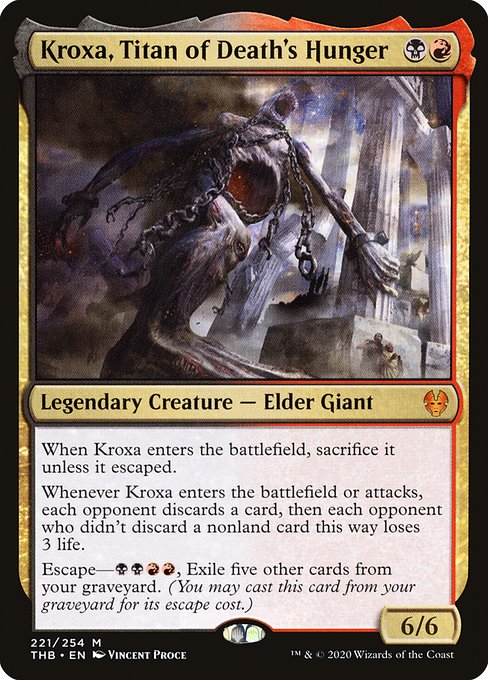
The titans got a ton of hype for cube early. While I do like the idea of them both in the abstract, Kroxa is the more cubeable of the two titans. Mostly this comes down to the archetype play patterns of Rakdos versus Simic. On its surface, running Kroxa out early has only very slight impact on the game if we can’t escape it. Rakdos, whether considering aggro or midrange, is extremely capable of filling its graveyard with removal spells, looting effects, and cheap expendible creatures. This makes envisioning Kroxa to escape early, and perhaps even often, a reasonable bit of entertainment.
So, yeah, if you can escape Kroxa onto the battlefield the card is excellent. Otherwise it’s a superbly mediocre effect that is likely to take up space in a color-pair overflowing with early plays and efficient disruption elements.
Uro, Titan of Nature’s Wrath
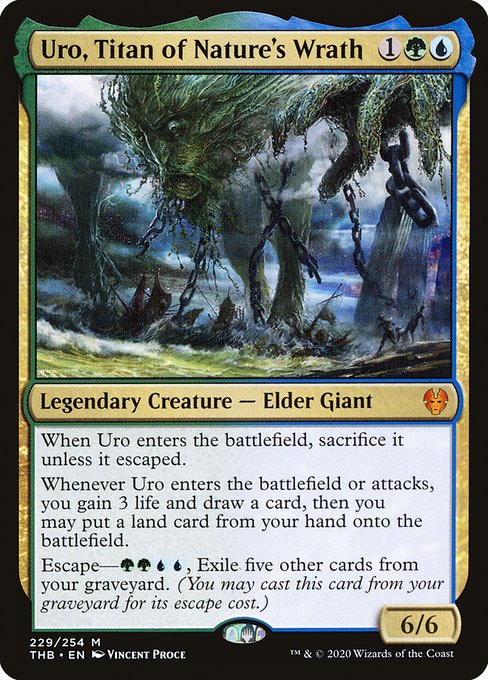
Uro, on the other hand, is more contentious a card among the cube community. And honestly, I don’t see what all the hubbub is about. We can agree Uro has a better front-facing ETB trigger: providing three life, a card, and an extra land drop is a fine use of three mana. It’s nothing exceptional, but it does help midrange decks against aggro. Taking a turn off to ramp while behind on board is never where you want to be, so the life helps alleviate the cost. The real problem I have with Uro is the frequency at which you can reasonably escape. I think this factor depends heavily on a couple of very specific and important things.
First, your color balance must skew blue, not green. If your cube is more apt to dumping cards into the graveyard early and often, this works. However if green is your base color you’re unlikely to even see five cards enter your graveyard over the course of a game. This is a big dealbreaker for me; if all I’m reliably getting for my card is a better Explore for three mana, that’s not worth a slot in my deck, or my cube. If I’m reliably able to escape 1.5 times per game, the cube you’re likely running Uro in supports more unfair Magic. In which case, this card will play well more consistently.
The other factor is mana. UUGG is no joke, so expect this to be an awkward cast until later in the game. Make no mistake, the value you get here is real. My issue is one of reliability, not of power level. The more unfair your cube, the better-positioned Uro will be.
Polukranos, Unchained
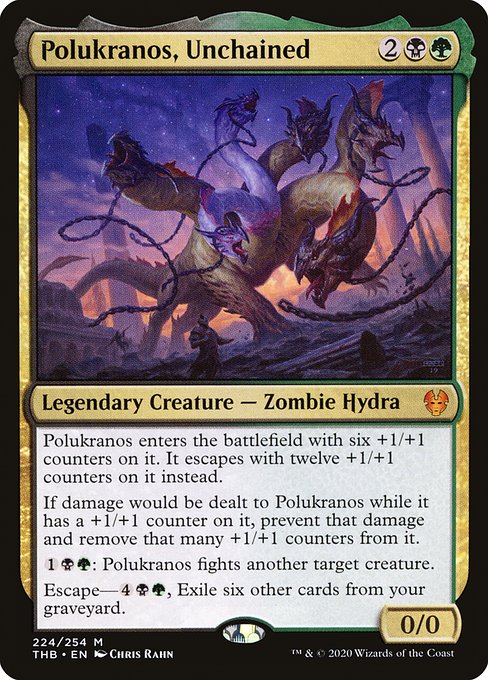
While a powerful bomb in retail limited, Polukranos kinda sucks for cube. Paul U. Kranos comes down with Keyword: Large and with an overcosted ability to kill small-to-medium sized creatures. This is fine, unexciting, and far less interesting than what we are used to seeing from Golgari gold cards. Like with Uro, your cube’s ability to dump cards into its graveyard is going to dictate the recursive power here. Ultimately Polukranos is slow, clunky, needs the right matchups to succeed—and doesn’t pull me towards this color combination.
Dream Trawler

After losing to it at the Grand Prix I was excited to put Dream Trawler in my cube. It mixed with my desire for a finisher in a low power environment. In practice Dream Trawler was very expensive and quickly went against the cube’s plan to bolster control with more sweepers and planeswalkers. Once the cube sped up and the power level kicked up a notch, Dream Trawler became Teferi, Hero of Dominaria. For low power cubes that want non-planeswalker finishers this card is a powerful inclusion.
Kunoros, Hound of Athreos
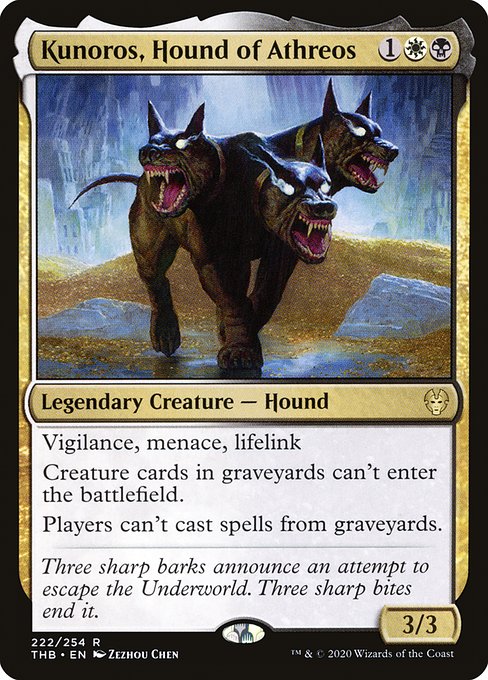
I’m big on Orzhov Disruption in powered cube. The combination of Thoughtseize and Mesmeric Fiend blended with cheap White creatures and great removal has carried me through many a draft. Hatebears are supremely powerful effects when surrounded by unfair nonsense, which drives me to consider Kunoros, Hound of Athreos as a possible addition to the mix.
The ability to stop Reanimate and Yawgmoth’s Will with a single creature is certainly entertaining, if a bit slow. Outside of these unfair environments our access to hate like this is more polarizing than it is disruptive, with the creature itself is more easily interacted with once we’re dealing with bread and butter Magic cards. This card is cute, but unlike Thalia, Guardian of Thraben or Containment Priest is likely far too narrow to be reliable. This is to say nothing of how wheelable it is in a pack.
Acolyte of Affliction
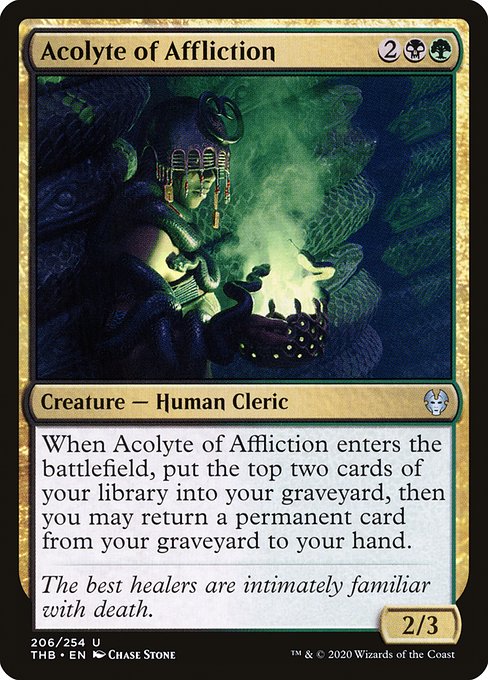
Rarity restricted cubes which entertained Golgari Findbroker now have a strictly better version to bolster their graveyard-centric strategies. The body is fine if unexciting, and the little bit of self-mill gives me a ray of hope that finding my Spider Spawning is something I can rely on a little more.
Hero of the Nyxborn
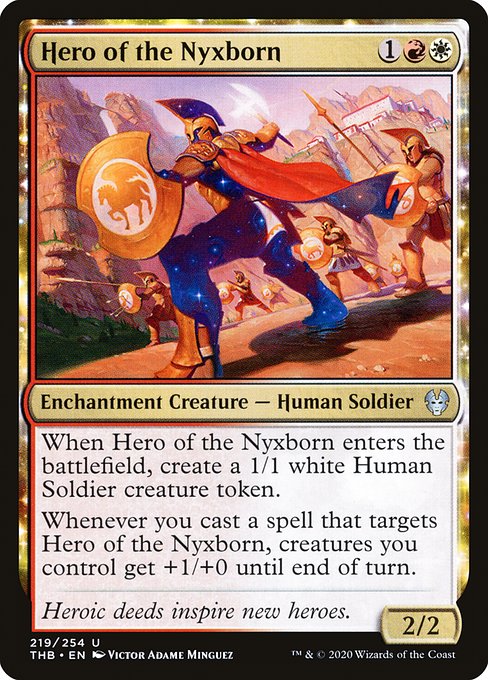
Hero of the Nyxborn offers a good rate for Boros go-wide decks with a heroic subtheme. Perfect for rarity restricted cubes as it’s on-plan for what we’ve come to expect from our beatdown decks.
Rise to Glory

Rise to Glory is only playable in cubes which specifically support aura-based removal in a slow Orzhov midrange or control shell. It’s expensive and unreliable at best, but I’m a fan of these slow value cards. It’s probably too narrow and bad, but I can’t help myself with cards that promise graveyard shenanigans and late game value. For rarity restricted cubes only.
Slaughter-Priest of Mogis
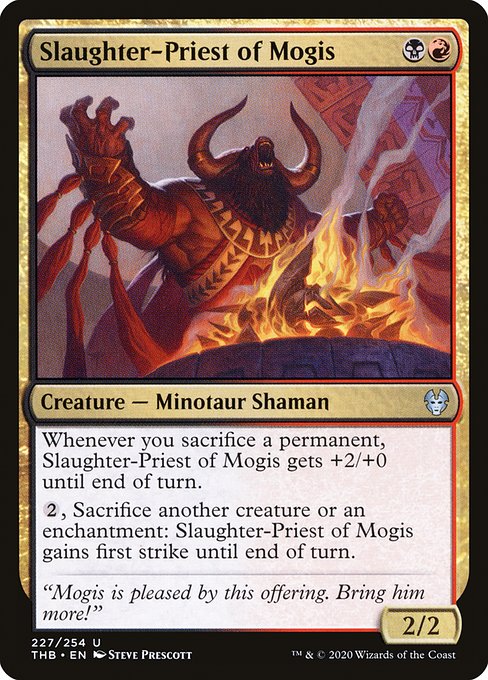
As a payoff for the mythical Rakdos sacrifice deck, Slaughter-Priest of Mogis is guaranteed to come straight to you during the draft as no one else will want it. This makes it more of a reward, and not a reason to go into the deck. Reserve the reason-cards for something like Goblin Bombardment, much easier to cast and pulls you right into the sacrifice deck.
Don’t put cards like Slaughter-Priest into your cube. They’re much too parasitic, even for a critical mass archetype like “Aristocrats”—I don’t know why we still use that term—when there are better payoffs available in mono-colored cards.
Shadowspear
Shadowspear
Cheap equipment is important for aggro support. While Shadowspear gives us a decent stat bump for our investment, I think we can do better. Bloodforged Battle-Axe and Trusty Machete are strictly better than Shadowspear. Decks that want equipment don’t need lifegain, and Trample doesn’t interact well with small creatures.
Shadowspear’s activated ability will be randomly disruptive at times, but this effect is much better suited to constructed. If your cube is large and you need to max out on redundancy for cheap equipment this card is servicable, but I would avoid it otherwise.
Power Rankings—Multicolor & Colorless
Powered Cubes:
- Ashiok, Nightmare Muse
- Kroxa, Titan of Death’s Hunger
- Uro, Titan of Nature’s Wrath
- Dream Trawler
- Shadowspear
Peasant/Pauper Cubes:
Gold falls short on strong inclusions from Theros Beyond Death. Overall I’m really happy with how Ashiok has played out, and the Uro discussion continues to yield fruit. Theros was a wonderful set to test, and I’m happy you came along for the ride.
Next week I’ll be giving you some hot takes for cube testing from Ikoria. Thanks for reading!

